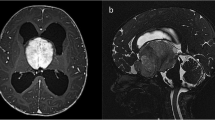Abstract
The prevalence of hydrocephalus among patients with neurofibromatosis type I (NF1) is estimated to be between 1 and 13%. Most hydrocephalic causes are obstructive—aqueductal webs, chiasmatic-hypothalamic tumors, and thalamic mass effect related to NF changes. Other NF1-related conditions may mimic the clinical presentation of hydrocephalus and should be ruled out while evaluating children with headaches. These include brain tumors and moyamoya syndrome. Treatment of NF1-related hydrocephalus should be personally tailored, including tumor resection or debulking, shunts, and endoscopic procedures such as septostomy and third ventriculostomy. Despite these personalized treatments, many of the primary treatments (including shunts and endoscopic procedures) fail, and patients should be screened and followed accordingly. In the current manuscript, we review the causes of NF1-related hydrocephalus, as well as treatment options.






Similar content being viewed by others
References
Hirabaru K, Matsuo M (2018) Neurological comorbidity in children with neurofibromatosis type 1. Pediatr Int 60:70–75
Clementi M, Battistella PA, Rizzi L, Boni S, Tenconi R (1996) Headache in patients with neurofibromatosis type 1. Headache 36:10–13
Creange A, Zeller J, Rostaing-Rigattieri S, Brugieres P, Degos JD, Revuz J, Wolkenstein P (1999) Neurological complications of neurofibromatosis type 1 in adulthood. Brain J Neurol 122(Pt 3):473–481
Dincer A, Yener U, Ozek MM (2011) Hydrocephalus in patients with neurofibromatosis type 1: MR imaging findings and the outcome of endoscopic third ventriculostomy. AJNR Am J Neuroradiol 32:643–646
Hosoda K, Kanazawa Y, Tanaka J, Tamaki N, Matsumoto S (1986) Neurofibromatosis presenting with aqueductal stenosis due to a tumor of the aqueduct: case report. Neurosurgery 19:1035–1037
Roth J, Ber R, Wisoff JH, Hidalgo ET, Limbrick DD, Berger DS, Thomale UW, Schulz M, Cinalli G, Santoro C, Constantini S (2017) Endoscopic third ventriculostomy in patients with neurofibromatosis type 1: a multicenter international experience. World Neurosurg 107:623–629
Afifi AK, Jacoby CG, Bell WE, Menezes AH (1988) Aqueductal stenosis and neurofibromatosis: a rare association. J Child Neurol 3:125–130
Balestrazzi P, de Gressi S, Donadio A, Lenzini S (1989) Periaqueductal gliosis causing hydrocephalus in a patient with neurofibromatosis type 1. Neurofibromatosis 2:322–325
Garg P, Shruthi KM, Maheshwaran V, Devanand B (2016) Rare case of non-neoplastic aqueductal stenosis due to web in a patient with neurofibromatosis type-1. Neurol India 64:1384–1387
Shofty B, Ben-Sira L, Toledano-Alhadef H, Bokstein F, Constantini S (2018) Neurofibromatosis type 1. In: Jallo GI, Kothbauer K, Recinos V (eds) Handbook of Pediatric Neurosurgery. Thieme
Roth J, Ber R, Constantini S (2019) Neurofibromatosis type 1-related hydrocephalus: treatment options and considerations. World Neurosurg 128:e664–e668
Allen JC (2000) Initial management of children with hypothalamic and thalamic tumors and the modifying role of neurofibromatosis-1. Pediatr Neurosurg 32:154–162
Pollack IF, Shultz B, Mulvihill JJ (1996) The management of brainstem gliomas in patients with neurofibromatosis 1. Neurology 46:1652–1660
Senveli E, Altinors N, Kars Z, Arda N, Turker A, Cinar N, Yalniz Z (1989) Association of von Recklinghausen’s neurofibromatosis and aqueduct stenosis. Neurosurgery 24:99–101
Kang YS, Park EK, Kim YO, Kim JS, Kim DS, Thomale UW, Shim KW (2017) Altered cerebrospinal fluid dynamics in neurofibromatosis type l: severe arachnoid thickening in patients with neurofibromatosis type 1 may cause abnormal CSF dynamic. Childs Nerv Syst 33:767–775
Fangusaro J, Onar-Thomas A, Young Poussaint T, Wu S, Ligon AH, Lindeman N, Banerjee A, Packer RJ, Kilburn LB, Goldman S, Pollack IF, Qaddoumi I, Jakacki RI, Fisher PG, Dhall G, Baxter P, Kreissman SG, Stewart CF, Jones DTW, Pfister SM, Vezina G, Stern JS, Panigrahy A, Patay Z, Tamrazi B, Jones JY, Haque SS, Enterline DS, Cha S, Fisher MJ, Doyle LA, Smith M, Dunkel IJ, Fouladi M (2019) Selumetinib in paediatric patients with BRAF-aberrant or neurofibromatosis type 1-associated recurrent, refractory, or progressive low-grade glioma: a multicentre, phase 2 trial. Lancet Oncol 20:1011–1022
Bavle A, Jones J, Lin FY, Malphrus A, Adesina A, Su J (2017) Dramatic clinical and radiographic response to BRAF inhibition in a patient with progressive disseminated optic pathway glioma refractory to MEK inhibition. Pediatr Hematol Oncol 34:254–259
Goodden J, Pizer B, Pettorini B, Williams D, Blair J, Didi M, Thorp N, Mallucci C (2014) The role of surgery in optic pathway/hypothalamic gliomas in children. J Neurosurg Pediatr 13:1–12
Binning MJ, Liu JK, Kestle JR, Brockmeyer DL, Walker ML (2007) Optic pathway gliomas: a review. Neurosurg Focus 23:E2
El Beltagy MA, Reda M, Enayet A, Zaghloul MS, Awad M, Zekri W, Taha H, El-Khateeb N (2016) Treatment and outcome in 65 children with optic pathway gliomas. World Neurosurg 89:525–534
Shuper A, Kornreich L, Michowitz S, Schwartz M, Yaniv I, Cohen IJ (2000) Visual pathway tumors and hydrocephalus. Pediatr Hematol Oncol 17:463–468
Gil Z, Beni-Adani L, Siomin V, Nagar H, Dvir R, Constantini S (2001) Ascites following ventriculoperitoneal shunting in children with chiasmatic-hypothalamic glioma. Childs Nerv Syst 17:395–398
Cinalli G, Imperato A, Mirone G, Di Martino G, Nicosia G, Ruggiero C, Aliberti F, Spennato P (2017) Initial experience with endoscopic ultrasonic aspirator in purely neuroendoscopic removal of intraventricular tumors. J Neurosurg Pediatr 19:325–332
Schulz M, Spors B, Thomale UW (2015) Stented endoscopic third ventriculostomy-indications and results. Childs Nerv Syst 31:1499–1507
Roth J, Ram Z, Constantini S (2015) Endoscopic considerations treating hydrocephalus caused by basal ganglia and large thalamic tumors. Surg Neurol Int 6:56
Bilaniuk LT, Molloy PT, Zimmerman RA, Phillips PC, Vaughan SN, Liu GT, Sutton LN, Needle M (1997) Neurofibromatosis type 1: brain stem tumours. Neuroradiology 39:642–653
Molloy PT, Bilaniuk LT, Vaughan SN, Needle MN, Liu GT, Zackai EH, Phillips PC (1995) Brainstem tumors in patients with neurofibromatosis type 1: a distinct clinical entity. Neurology 45:1897–1902
Author information
Authors and Affiliations
Corresponding author
Ethics declarations
Conflict of interest
The authors declare that they have no conflict of interest.
Additional information
Publisher’s note
Springer Nature remains neutral with regard to jurisdictional claims in published maps and institutional affiliations.
Rights and permissions
About this article
Cite this article
Roth, J., Constantini, S. & Cinalli, G. Neurofibromatosis type 1–related hydrocephalus: causes and treatment considerations. Childs Nerv Syst 36, 2385–2390 (2020). https://doi.org/10.1007/s00381-020-04719-y
Received:
Accepted:
Published:
Issue Date:
DOI: https://doi.org/10.1007/s00381-020-04719-y




